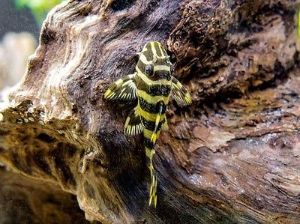
L134 Leopard Frog the Imperial Tiger Pleco (Peckoltia compta) is a member of the Loricariidae family of South American suckermouth catfishes

The strong>Imperial Tiger Pleco/strong> (Peckoltia compta) is a type of South American suckermouth catfish. It is also known as the strong>L134 Leopard Frog Pleco (Peckoltia compta)/strong>. This fish's zebra-like stripes and friendly nature make it a great addition to any planted or nano aquarium. They range in color from a pale beige to a vibrant sunshine yellow. We are excited to be one of the first stores to offer tank-raised juvenile Leopard Frog Plecos at a price that is significantly lower than that of wild-caught specimens.
The Leopard Frog Pleco is a peaceful and hardy addition to any aquarium. However, unlike the more common Common Pleco (Hypostomus plecostomus) and Trinidad Pleco (Hypostomus punctatus), this species only reaches a maximum length of 3.5-4.2 inches (9.5-10.5 cm) (8.9 to 10.7 cm). Due to its small size, the pleco can thrive in an aquarium as small as 30 to 40 gallons, provided it receives adequate care. Although male plecos have a reputation for being territorial, most disputes can be avoided by providing ample space and hiding areas for all fish. It's possible, though unlikely, that the leopard frog pleco in your aquarium will prey on the shrimp fry you keep there. However, it is not uncommon for large-scale shrimp suppliers to also raise Leopard Frog Plecos in the same tanks as their shrimp.
When the Leopard Frog Pleco is comfortable in its new environment, which should include plenty of driftwood, rockwork, and other hiding spots, it will likely be active during the day. It is not known to eat as much wood as other plecos (Panaque speciosum, etc.), but occasional supplementation with wood may be beneficial (or bio-film on driftwood). Leopard frogs like Pleco are able to eat just about anything, including plants, but they aren't good at consuming algae. Leopard Frog Pleco's diet should include meat, but high-quality vegetable flakes, sinking algae wafers, and pellets can help round out its meal. This omnivorous species requires a high-protein diet rich in meaty items, so frozen foods like bloodworms and Tubifex are ideal. It thrives on a variety of fresh vegetables, including shelled peas, spinach, zucchini, and cucumber.

References
Albino Bushy Nose Pleco (Ancistrus sp.) is a member of the Loricariidae family of South American suckermouth catfishesAsian Stone Mini Catfish (Hara jerdoni) Their small size makes them perfect for small tanks - they only grow to a maximum of 1 1/2 inches in length
Banjo Catfish (Bunocephalus coracoideus) this catfish is popular because of its strange appearance
Bristlenose Pleco (Ancistrus sp.) is a member of the Loricariidae family of South American suckermouth catfishes
Corydoras sterbai (Sterba's Corydoras) are among the most popular of the numerous currently known species within the Corydora classification
L134 Leopard Frog the Imperial Tiger Pleco (Peckoltia compta) is a member of the Loricariidae family of South American suckermouth
L201 Snowball Pleco (Hypancistrus inspector) also known as the Orinoco Angel Pleco, is a member of the Loricariidae family of South American suckermouth catfishes
L333 King Tiger Pleco (Hypancistrus sp.) is primarily nocturnal, but will often become active during daytime hours once established in an aquarium with plenty of driftwood, rockwork
L340 Mega Clown AKA Imperial Tiger Pleco (Hypancistrus sp.)
Otocinclus Catfish known as Otto Cats, otos, or dwarf suckermouth catfish
Panda Cory Catfish (Corydoras panda) is a very animated, distinctively marked schooling fish that is perfect for the community and planted aquarium
Rio Ucayali Bristlenose Pleco is a member of the Loricariidae family of South American suckermouth catfishes. While many suckermouth catfish species have yet to be bred commercially in aquariums, the very rare Orange Spot Bristlenose Pleco is now available





